Financial Management and Analysis: Importance, Financial Statements, Ratios, and Case Study Analysis
VerifiedAdded on 2023/06/14
|14
|2572
|341
AI Summary
This report discusses the importance of financial management, major financial statements, usage of ratios in financial management, and a case study analysis. It includes profitability, liquidity, and efficiency ratios along with suggestions for improving fiscal action.
Contribute Materials
Your contribution can guide someone’s learning journey. Share your
documents today.

3005
Secure Best Marks with AI Grader
Need help grading? Try our AI Grader for instant feedback on your assignments.
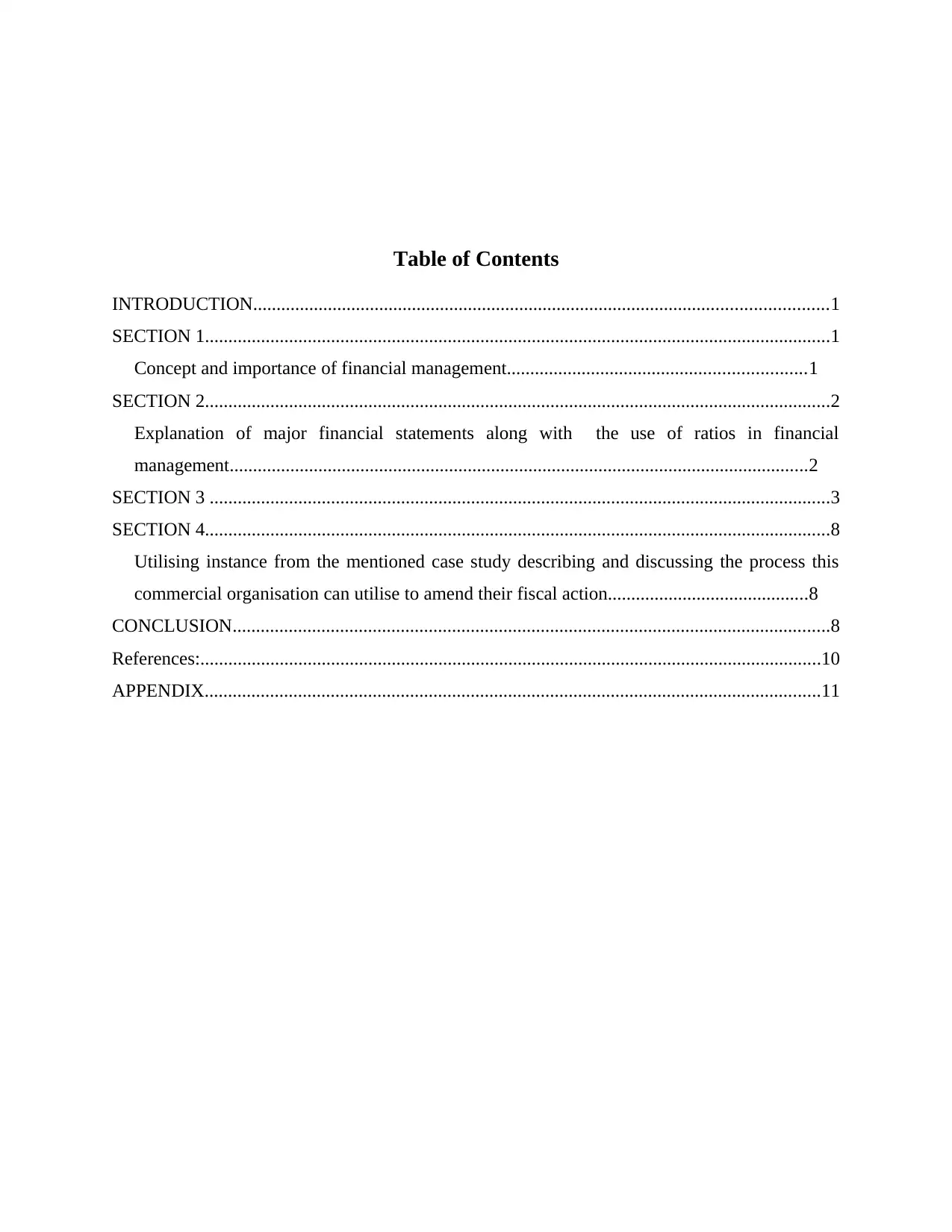
Table of Contents
INTRODUCTION...........................................................................................................................1
SECTION 1......................................................................................................................................1
Concept and importance of financial management................................................................1
SECTION 2......................................................................................................................................2
Explanation of major financial statements along with the use of ratios in financial
management............................................................................................................................2
SECTION 3 .....................................................................................................................................3
SECTION 4......................................................................................................................................8
Utilising instance from the mentioned case study describing and discussing the process this
commercial organisation can utilise to amend their fiscal action...........................................8
CONCLUSION................................................................................................................................8
References:.....................................................................................................................................10
APPENDIX....................................................................................................................................11
INTRODUCTION...........................................................................................................................1
SECTION 1......................................................................................................................................1
Concept and importance of financial management................................................................1
SECTION 2......................................................................................................................................2
Explanation of major financial statements along with the use of ratios in financial
management............................................................................................................................2
SECTION 3 .....................................................................................................................................3
SECTION 4......................................................................................................................................8
Utilising instance from the mentioned case study describing and discussing the process this
commercial organisation can utilise to amend their fiscal action...........................................8
CONCLUSION................................................................................................................................8
References:.....................................................................................................................................10
APPENDIX....................................................................................................................................11
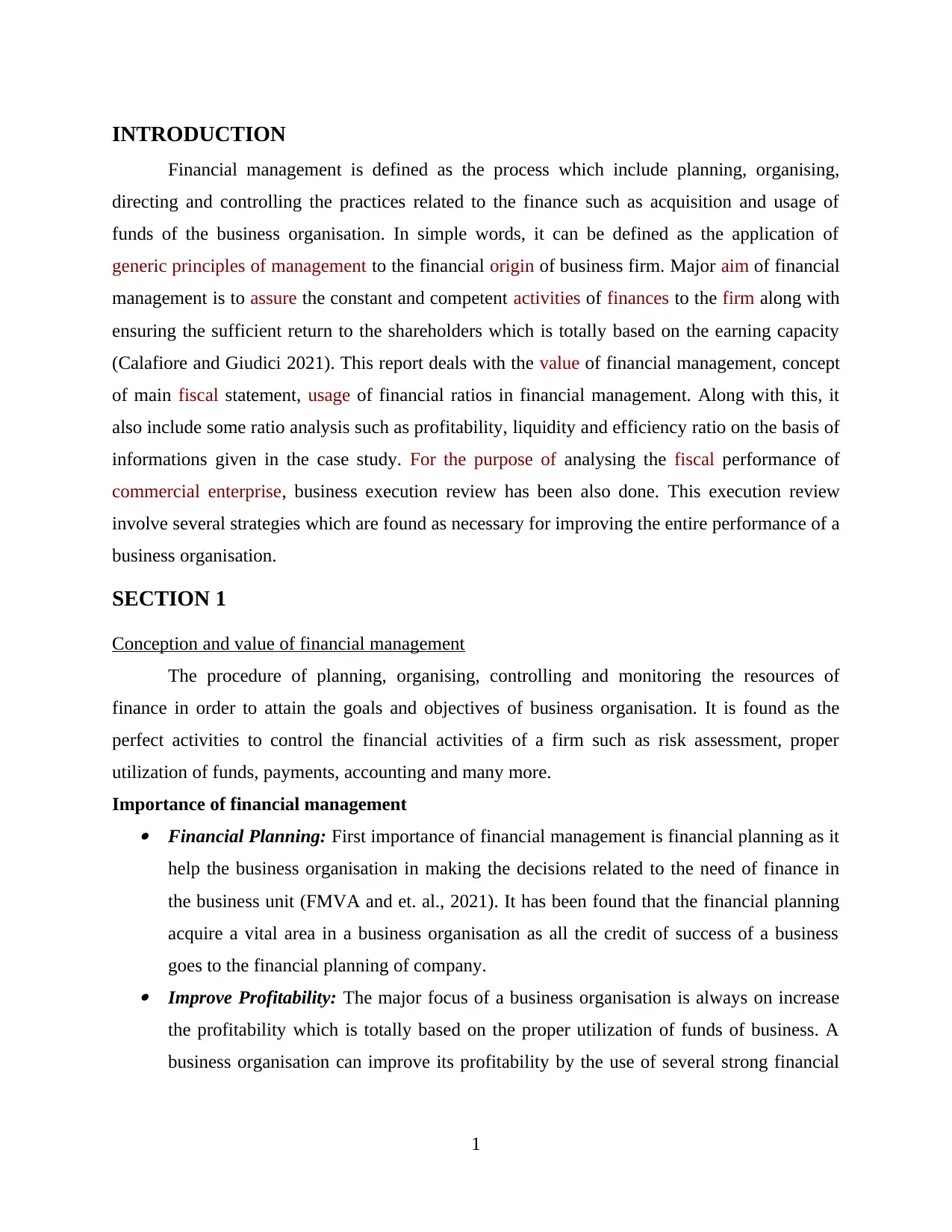
INTRODUCTION
Financial management is defined as the process which include planning, organising,
directing and controlling the practices related to the finance such as acquisition and usage of
funds of the business organisation. In simple words, it can be defined as the application of
generic principles of management to the financial origin of business firm. Major aim of financial
management is to assure the constant and competent activities of finances to the firm along with
ensuring the sufficient return to the shareholders which is totally based on the earning capacity
(Calafiore and Giudici 2021). This report deals with the value of financial management, concept
of main fiscal statement, usage of financial ratios in financial management. Along with this, it
also include some ratio analysis such as profitability, liquidity and efficiency ratio on the basis of
informations given in the case study. For the purpose of analysing the fiscal performance of
commercial enterprise, business execution review has been also done. This execution review
involve several strategies which are found as necessary for improving the entire performance of a
business organisation.
SECTION 1
Conception and value of financial management
The procedure of planning, organising, controlling and monitoring the resources of
finance in order to attain the goals and objectives of business organisation. It is found as the
perfect activities to control the financial activities of a firm such as risk assessment, proper
utilization of funds, payments, accounting and many more.
Importance of financial management Financial Planning: First importance of financial management is financial planning as it
help the business organisation in making the decisions related to the need of finance in
the business unit (FMVA and et. al., 2021). It has been found that the financial planning
acquire a vital area in a business organisation as all the credit of success of a business
goes to the financial planning of company. Improve Profitability: The major focus of a business organisation is always on increase
the profitability which is totally based on the proper utilization of funds of business. A
business organisation can improve its profitability by the use of several strong financial
1
Financial management is defined as the process which include planning, organising,
directing and controlling the practices related to the finance such as acquisition and usage of
funds of the business organisation. In simple words, it can be defined as the application of
generic principles of management to the financial origin of business firm. Major aim of financial
management is to assure the constant and competent activities of finances to the firm along with
ensuring the sufficient return to the shareholders which is totally based on the earning capacity
(Calafiore and Giudici 2021). This report deals with the value of financial management, concept
of main fiscal statement, usage of financial ratios in financial management. Along with this, it
also include some ratio analysis such as profitability, liquidity and efficiency ratio on the basis of
informations given in the case study. For the purpose of analysing the fiscal performance of
commercial enterprise, business execution review has been also done. This execution review
involve several strategies which are found as necessary for improving the entire performance of a
business organisation.
SECTION 1
Conception and value of financial management
The procedure of planning, organising, controlling and monitoring the resources of
finance in order to attain the goals and objectives of business organisation. It is found as the
perfect activities to control the financial activities of a firm such as risk assessment, proper
utilization of funds, payments, accounting and many more.
Importance of financial management Financial Planning: First importance of financial management is financial planning as it
help the business organisation in making the decisions related to the need of finance in
the business unit (FMVA and et. al., 2021). It has been found that the financial planning
acquire a vital area in a business organisation as all the credit of success of a business
goes to the financial planning of company. Improve Profitability: The major focus of a business organisation is always on increase
the profitability which is totally based on the proper utilization of funds of business. A
business organisation can improve its profitability by the use of several strong financial
1
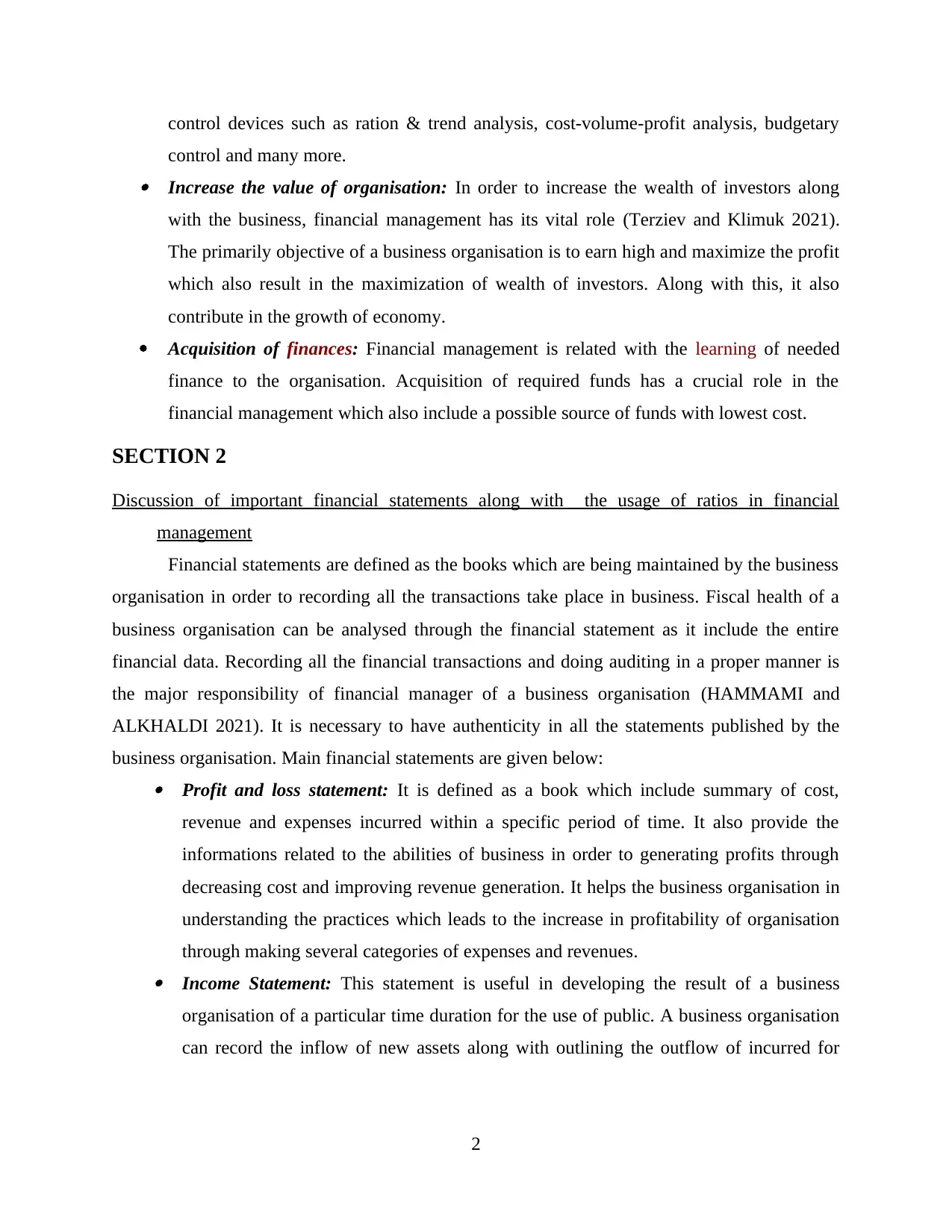
control devices such as ration & trend analysis, cost-volume-profit analysis, budgetary
control and many more. Increase the value of organisation: In order to increase the wealth of investors along
with the business, financial management has its vital role (Terziev and Klimuk 2021).
The primarily objective of a business organisation is to earn high and maximize the profit
which also result in the maximization of wealth of investors. Along with this, it also
contribute in the growth of economy.
Acquisition of finances: Financial management is related with the learning of needed
finance to the organisation. Acquisition of required funds has a crucial role in the
financial management which also include a possible source of funds with lowest cost.
SECTION 2
Discussion of important financial statements along with the usage of ratios in financial
management
Financial statements are defined as the books which are being maintained by the business
organisation in order to recording all the transactions take place in business. Fiscal health of a
business organisation can be analysed through the financial statement as it include the entire
financial data. Recording all the financial transactions and doing auditing in a proper manner is
the major responsibility of financial manager of a business organisation (HAMMAMI and
ALKHALDI 2021). It is necessary to have authenticity in all the statements published by the
business organisation. Main financial statements are given below: Profit and loss statement: It is defined as a book which include summary of cost,
revenue and expenses incurred within a specific period of time. It also provide the
informations related to the abilities of business in order to generating profits through
decreasing cost and improving revenue generation. It helps the business organisation in
understanding the practices which leads to the increase in profitability of organisation
through making several categories of expenses and revenues. Income Statement: This statement is useful in developing the result of a business
organisation of a particular time duration for the use of public. A business organisation
can record the inflow of new assets along with outlining the outflow of incurred for
2
control and many more. Increase the value of organisation: In order to increase the wealth of investors along
with the business, financial management has its vital role (Terziev and Klimuk 2021).
The primarily objective of a business organisation is to earn high and maximize the profit
which also result in the maximization of wealth of investors. Along with this, it also
contribute in the growth of economy.
Acquisition of finances: Financial management is related with the learning of needed
finance to the organisation. Acquisition of required funds has a crucial role in the
financial management which also include a possible source of funds with lowest cost.
SECTION 2
Discussion of important financial statements along with the usage of ratios in financial
management
Financial statements are defined as the books which are being maintained by the business
organisation in order to recording all the transactions take place in business. Fiscal health of a
business organisation can be analysed through the financial statement as it include the entire
financial data. Recording all the financial transactions and doing auditing in a proper manner is
the major responsibility of financial manager of a business organisation (HAMMAMI and
ALKHALDI 2021). It is necessary to have authenticity in all the statements published by the
business organisation. Main financial statements are given below: Profit and loss statement: It is defined as a book which include summary of cost,
revenue and expenses incurred within a specific period of time. It also provide the
informations related to the abilities of business in order to generating profits through
decreasing cost and improving revenue generation. It helps the business organisation in
understanding the practices which leads to the increase in profitability of organisation
through making several categories of expenses and revenues. Income Statement: This statement is useful in developing the result of a business
organisation of a particular time duration for the use of public. A business organisation
can record the inflow of new assets along with outlining the outflow of incurred for
2
Secure Best Marks with AI Grader
Need help grading? Try our AI Grader for instant feedback on your assignments.
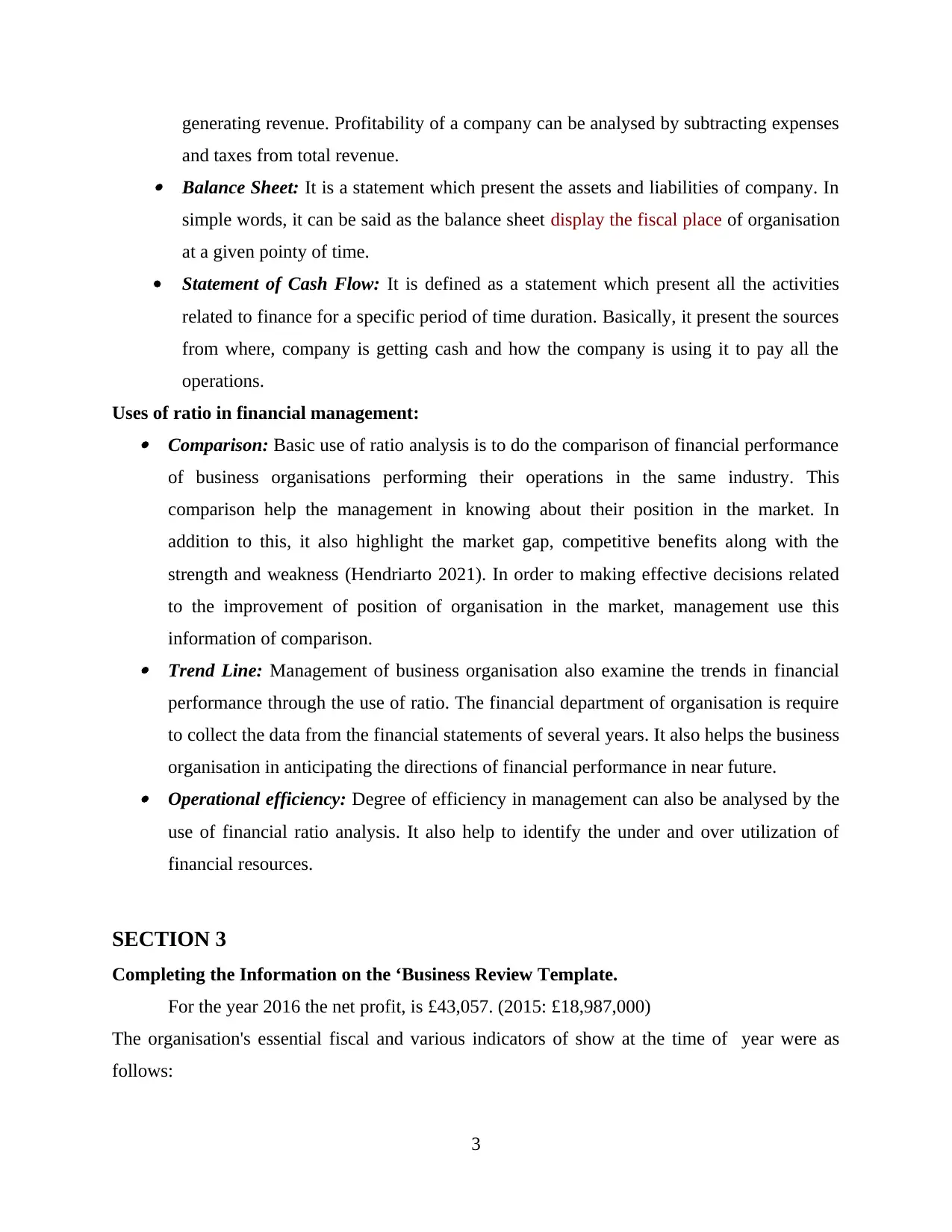
generating revenue. Profitability of a company can be analysed by subtracting expenses
and taxes from total revenue. Balance Sheet: It is a statement which present the assets and liabilities of company. In
simple words, it can be said as the balance sheet display the fiscal place of organisation
at a given pointy of time.
Statement of Cash Flow: It is defined as a statement which present all the activities
related to finance for a specific period of time duration. Basically, it present the sources
from where, company is getting cash and how the company is using it to pay all the
operations.
Uses of ratio in financial management: Comparison: Basic use of ratio analysis is to do the comparison of financial performance
of business organisations performing their operations in the same industry. This
comparison help the management in knowing about their position in the market. In
addition to this, it also highlight the market gap, competitive benefits along with the
strength and weakness (Hendriarto 2021). In order to making effective decisions related
to the improvement of position of organisation in the market, management use this
information of comparison. Trend Line: Management of business organisation also examine the trends in financial
performance through the use of ratio. The financial department of organisation is require
to collect the data from the financial statements of several years. It also helps the business
organisation in anticipating the directions of financial performance in near future. Operational efficiency: Degree of efficiency in management can also be analysed by the
use of financial ratio analysis. It also help to identify the under and over utilization of
financial resources.
SECTION 3
Completing the Information on the ‘Business Review Template.
For the year 2016 the net profit, is £43,057. (2015: £18,987,000)
The organisation's essential fiscal and various indicators of show at the time of year were as
follows:
3
and taxes from total revenue. Balance Sheet: It is a statement which present the assets and liabilities of company. In
simple words, it can be said as the balance sheet display the fiscal place of organisation
at a given pointy of time.
Statement of Cash Flow: It is defined as a statement which present all the activities
related to finance for a specific period of time duration. Basically, it present the sources
from where, company is getting cash and how the company is using it to pay all the
operations.
Uses of ratio in financial management: Comparison: Basic use of ratio analysis is to do the comparison of financial performance
of business organisations performing their operations in the same industry. This
comparison help the management in knowing about their position in the market. In
addition to this, it also highlight the market gap, competitive benefits along with the
strength and weakness (Hendriarto 2021). In order to making effective decisions related
to the improvement of position of organisation in the market, management use this
information of comparison. Trend Line: Management of business organisation also examine the trends in financial
performance through the use of ratio. The financial department of organisation is require
to collect the data from the financial statements of several years. It also helps the business
organisation in anticipating the directions of financial performance in near future. Operational efficiency: Degree of efficiency in management can also be analysed by the
use of financial ratio analysis. It also help to identify the under and over utilization of
financial resources.
SECTION 3
Completing the Information on the ‘Business Review Template.
For the year 2016 the net profit, is £43,057. (2015: £18,987,000)
The organisation's essential fiscal and various indicators of show at the time of year were as
follows:
3
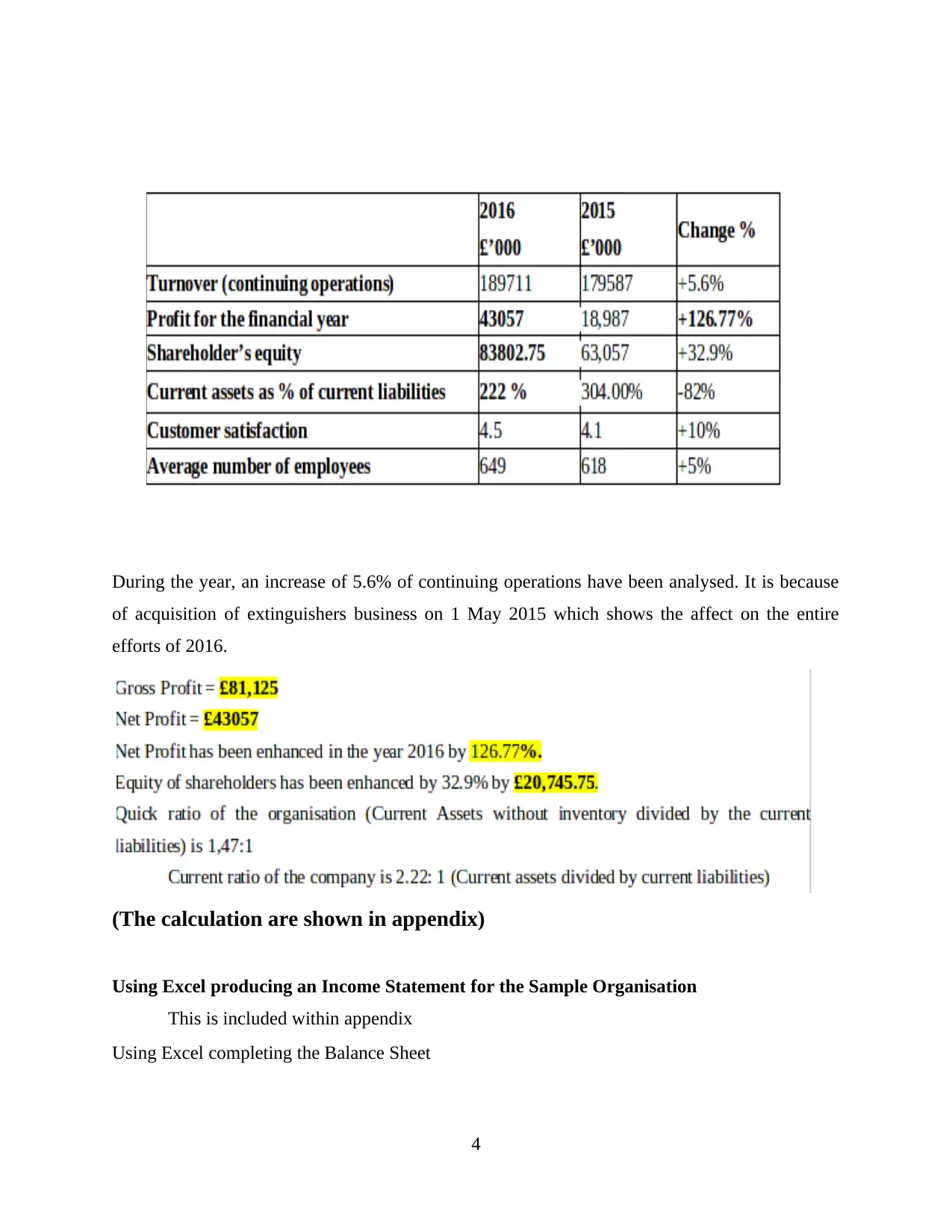
During the year, an increase of 5.6% of continuing operations have been analysed. It is because
of acquisition of extinguishers business on 1 May 2015 which shows the affect on the entire
efforts of 2016.
(The calculation are shown in appendix)
Using Excel producing an Income Statement for the Sample Organisation
This is included within appendix
Using Excel completing the Balance Sheet
4
of acquisition of extinguishers business on 1 May 2015 which shows the affect on the entire
efforts of 2016.
(The calculation are shown in appendix)
Using Excel producing an Income Statement for the Sample Organisation
This is included within appendix
Using Excel completing the Balance Sheet
4
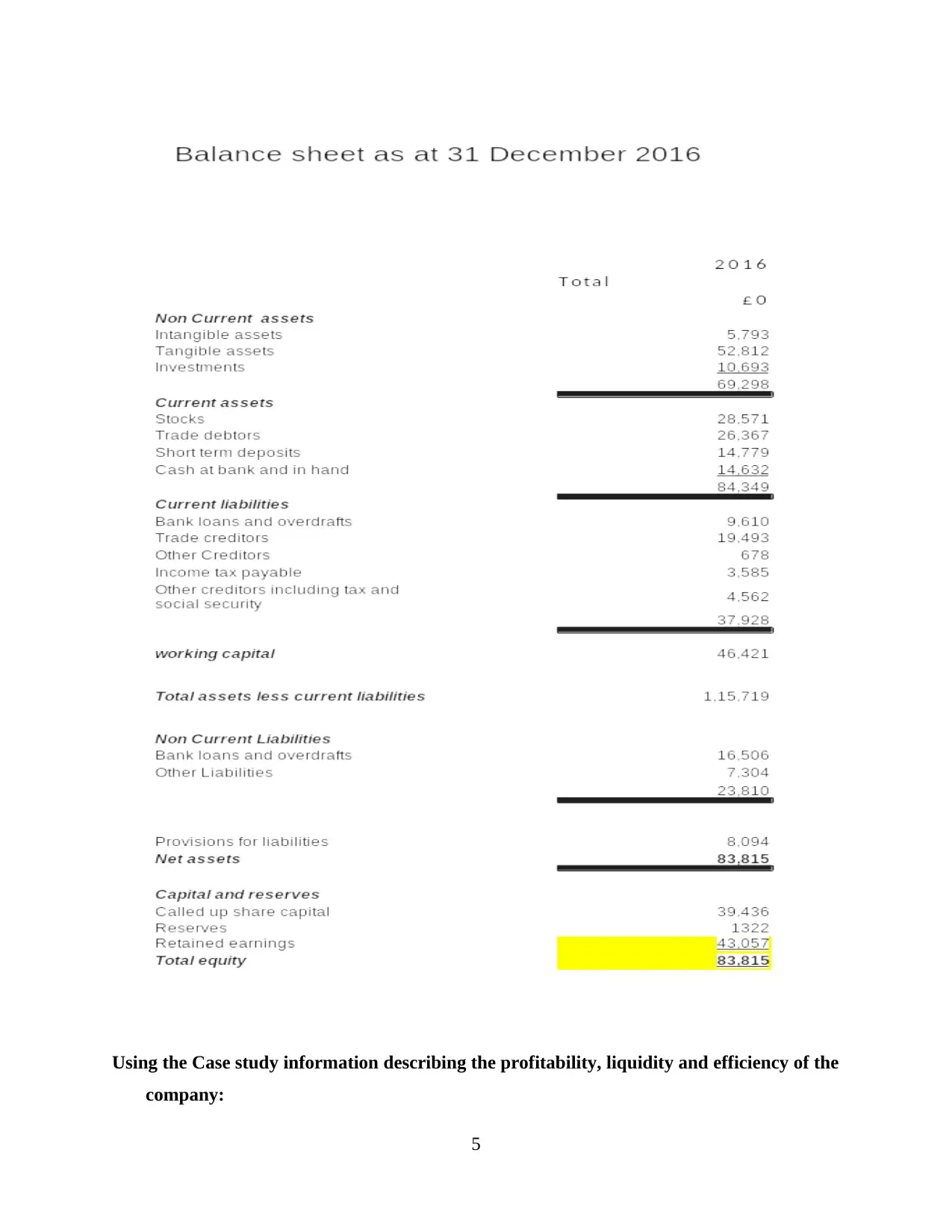
Using the Case study information describing the profitability, liquidity and efficiency of the
company:
5
company:
5
Paraphrase This Document
Need a fresh take? Get an instant paraphrase of this document with our AI Paraphraser
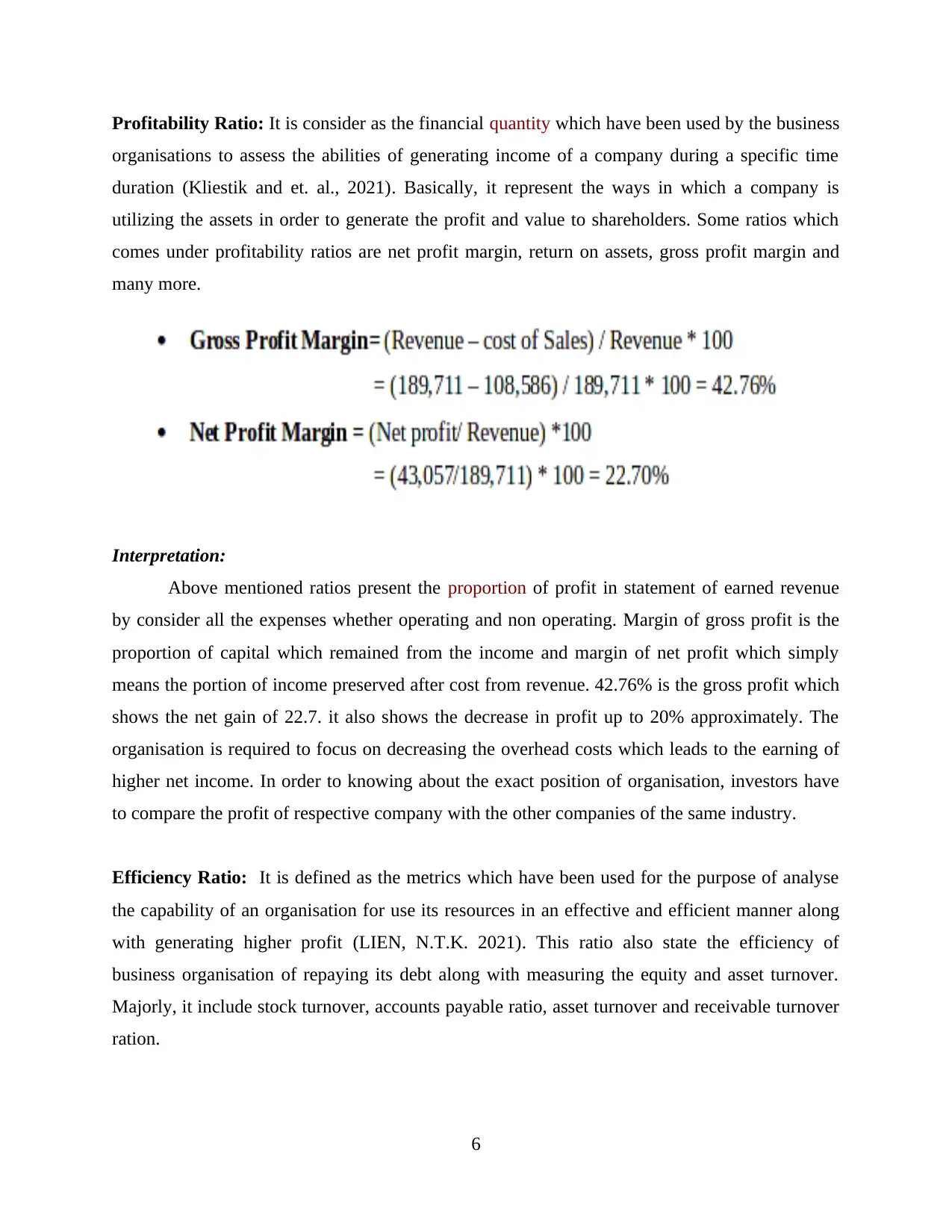
Profitability Ratio: It is consider as the financial quantity which have been used by the business
organisations to assess the abilities of generating income of a company during a specific time
duration (Kliestik and et. al., 2021). Basically, it represent the ways in which a company is
utilizing the assets in order to generate the profit and value to shareholders. Some ratios which
comes under profitability ratios are net profit margin, return on assets, gross profit margin and
many more.
Interpretation:
Above mentioned ratios present the proportion of profit in statement of earned revenue
by consider all the expenses whether operating and non operating. Margin of gross profit is the
proportion of capital which remained from the income and margin of net profit which simply
means the portion of income preserved after cost from revenue. 42.76% is the gross profit which
shows the net gain of 22.7. it also shows the decrease in profit up to 20% approximately. The
organisation is required to focus on decreasing the overhead costs which leads to the earning of
higher net income. In order to knowing about the exact position of organisation, investors have
to compare the profit of respective company with the other companies of the same industry.
Efficiency Ratio: It is defined as the metrics which have been used for the purpose of analyse
the capability of an organisation for use its resources in an effective and efficient manner along
with generating higher profit (LIEN, N.T.K. 2021). This ratio also state the efficiency of
business organisation of repaying its debt along with measuring the equity and asset turnover.
Majorly, it include stock turnover, accounts payable ratio, asset turnover and receivable turnover
ration.
6
organisations to assess the abilities of generating income of a company during a specific time
duration (Kliestik and et. al., 2021). Basically, it represent the ways in which a company is
utilizing the assets in order to generate the profit and value to shareholders. Some ratios which
comes under profitability ratios are net profit margin, return on assets, gross profit margin and
many more.
Interpretation:
Above mentioned ratios present the proportion of profit in statement of earned revenue
by consider all the expenses whether operating and non operating. Margin of gross profit is the
proportion of capital which remained from the income and margin of net profit which simply
means the portion of income preserved after cost from revenue. 42.76% is the gross profit which
shows the net gain of 22.7. it also shows the decrease in profit up to 20% approximately. The
organisation is required to focus on decreasing the overhead costs which leads to the earning of
higher net income. In order to knowing about the exact position of organisation, investors have
to compare the profit of respective company with the other companies of the same industry.
Efficiency Ratio: It is defined as the metrics which have been used for the purpose of analyse
the capability of an organisation for use its resources in an effective and efficient manner along
with generating higher profit (LIEN, N.T.K. 2021). This ratio also state the efficiency of
business organisation of repaying its debt along with measuring the equity and asset turnover.
Majorly, it include stock turnover, accounts payable ratio, asset turnover and receivable turnover
ration.
6
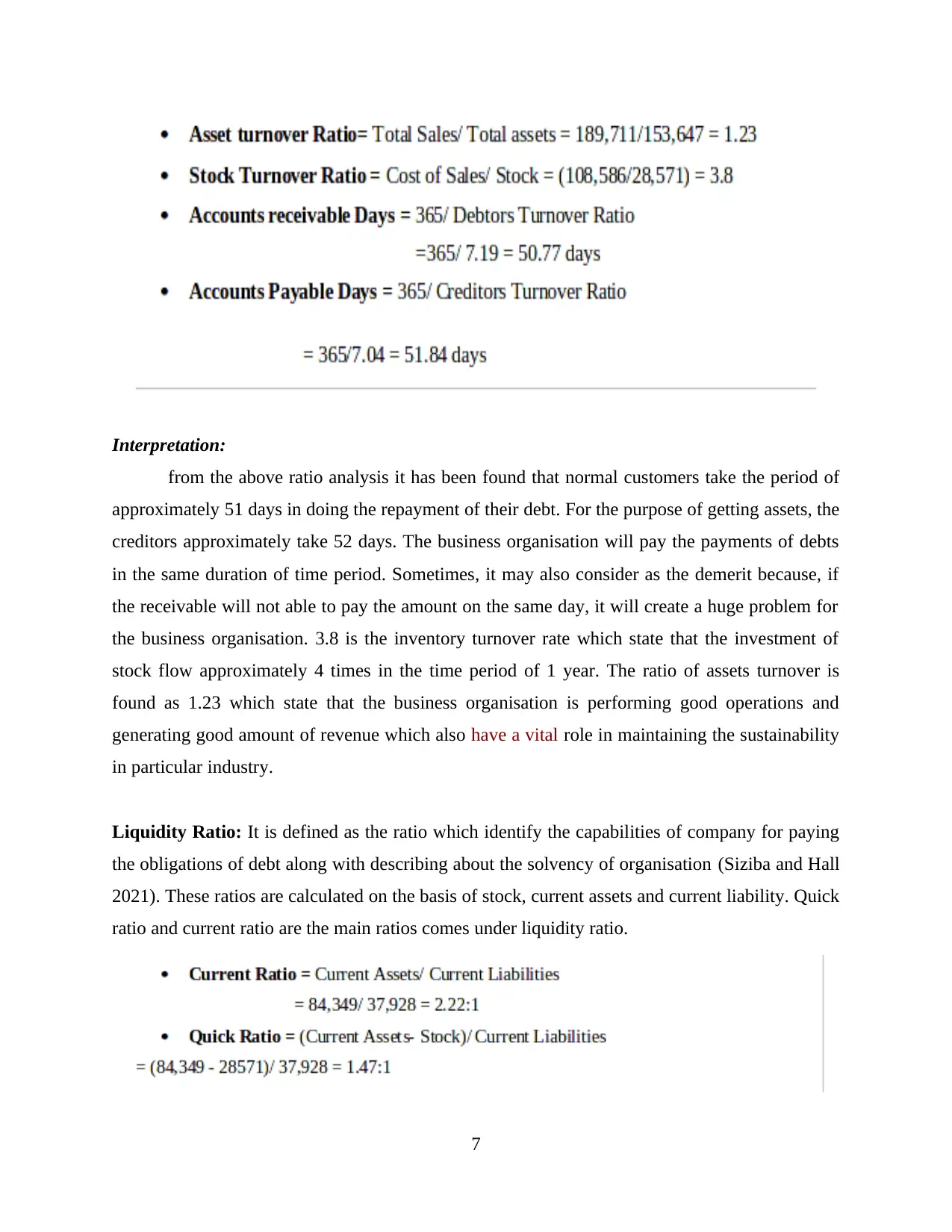
Interpretation:
from the above ratio analysis it has been found that normal customers take the period of
approximately 51 days in doing the repayment of their debt. For the purpose of getting assets, the
creditors approximately take 52 days. The business organisation will pay the payments of debts
in the same duration of time period. Sometimes, it may also consider as the demerit because, if
the receivable will not able to pay the amount on the same day, it will create a huge problem for
the business organisation. 3.8 is the inventory turnover rate which state that the investment of
stock flow approximately 4 times in the time period of 1 year. The ratio of assets turnover is
found as 1.23 which state that the business organisation is performing good operations and
generating good amount of revenue which also have a vital role in maintaining the sustainability
in particular industry.
Liquidity Ratio: It is defined as the ratio which identify the capabilities of company for paying
the obligations of debt along with describing about the solvency of organisation (Siziba and Hall
2021). These ratios are calculated on the basis of stock, current assets and current liability. Quick
ratio and current ratio are the main ratios comes under liquidity ratio.
7
from the above ratio analysis it has been found that normal customers take the period of
approximately 51 days in doing the repayment of their debt. For the purpose of getting assets, the
creditors approximately take 52 days. The business organisation will pay the payments of debts
in the same duration of time period. Sometimes, it may also consider as the demerit because, if
the receivable will not able to pay the amount on the same day, it will create a huge problem for
the business organisation. 3.8 is the inventory turnover rate which state that the investment of
stock flow approximately 4 times in the time period of 1 year. The ratio of assets turnover is
found as 1.23 which state that the business organisation is performing good operations and
generating good amount of revenue which also have a vital role in maintaining the sustainability
in particular industry.
Liquidity Ratio: It is defined as the ratio which identify the capabilities of company for paying
the obligations of debt along with describing about the solvency of organisation (Siziba and Hall
2021). These ratios are calculated on the basis of stock, current assets and current liability. Quick
ratio and current ratio are the main ratios comes under liquidity ratio.
7
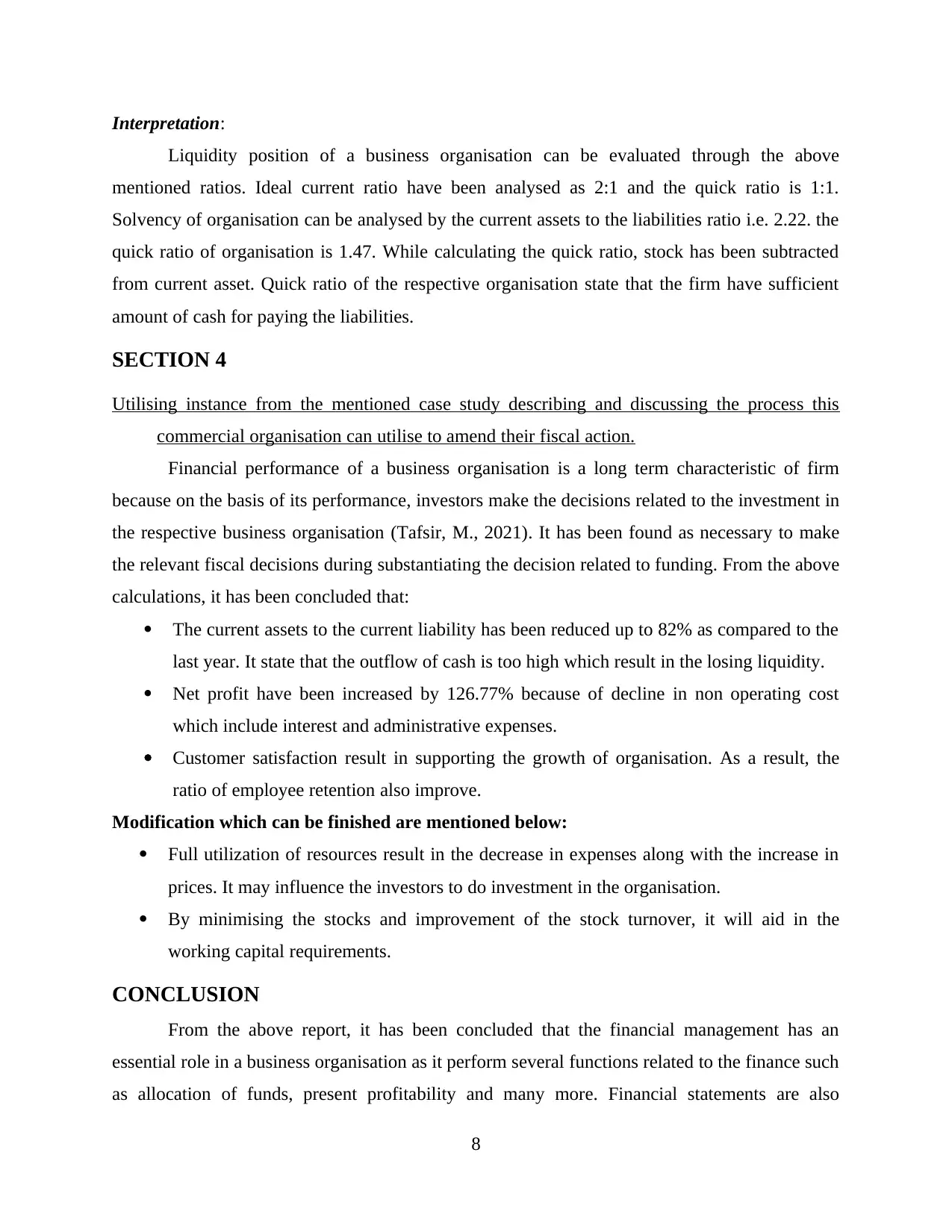
Interpretation:
Liquidity position of a business organisation can be evaluated through the above
mentioned ratios. Ideal current ratio have been analysed as 2:1 and the quick ratio is 1:1.
Solvency of organisation can be analysed by the current assets to the liabilities ratio i.e. 2.22. the
quick ratio of organisation is 1.47. While calculating the quick ratio, stock has been subtracted
from current asset. Quick ratio of the respective organisation state that the firm have sufficient
amount of cash for paying the liabilities.
SECTION 4
Utilising instance from the mentioned case study describing and discussing the process this
commercial organisation can utilise to amend their fiscal action.
Financial performance of a business organisation is a long term characteristic of firm
because on the basis of its performance, investors make the decisions related to the investment in
the respective business organisation (Tafsir, M., 2021). It has been found as necessary to make
the relevant fiscal decisions during substantiating the decision related to funding. From the above
calculations, it has been concluded that:
The current assets to the current liability has been reduced up to 82% as compared to the
last year. It state that the outflow of cash is too high which result in the losing liquidity.
Net profit have been increased by 126.77% because of decline in non operating cost
which include interest and administrative expenses.
Customer satisfaction result in supporting the growth of organisation. As a result, the
ratio of employee retention also improve.
Modification which can be finished are mentioned below:
Full utilization of resources result in the decrease in expenses along with the increase in
prices. It may influence the investors to do investment in the organisation.
By minimising the stocks and improvement of the stock turnover, it will aid in the
working capital requirements.
CONCLUSION
From the above report, it has been concluded that the financial management has an
essential role in a business organisation as it perform several functions related to the finance such
as allocation of funds, present profitability and many more. Financial statements are also
8
Liquidity position of a business organisation can be evaluated through the above
mentioned ratios. Ideal current ratio have been analysed as 2:1 and the quick ratio is 1:1.
Solvency of organisation can be analysed by the current assets to the liabilities ratio i.e. 2.22. the
quick ratio of organisation is 1.47. While calculating the quick ratio, stock has been subtracted
from current asset. Quick ratio of the respective organisation state that the firm have sufficient
amount of cash for paying the liabilities.
SECTION 4
Utilising instance from the mentioned case study describing and discussing the process this
commercial organisation can utilise to amend their fiscal action.
Financial performance of a business organisation is a long term characteristic of firm
because on the basis of its performance, investors make the decisions related to the investment in
the respective business organisation (Tafsir, M., 2021). It has been found as necessary to make
the relevant fiscal decisions during substantiating the decision related to funding. From the above
calculations, it has been concluded that:
The current assets to the current liability has been reduced up to 82% as compared to the
last year. It state that the outflow of cash is too high which result in the losing liquidity.
Net profit have been increased by 126.77% because of decline in non operating cost
which include interest and administrative expenses.
Customer satisfaction result in supporting the growth of organisation. As a result, the
ratio of employee retention also improve.
Modification which can be finished are mentioned below:
Full utilization of resources result in the decrease in expenses along with the increase in
prices. It may influence the investors to do investment in the organisation.
By minimising the stocks and improvement of the stock turnover, it will aid in the
working capital requirements.
CONCLUSION
From the above report, it has been concluded that the financial management has an
essential role in a business organisation as it perform several functions related to the finance such
as allocation of funds, present profitability and many more. Financial statements are also
8
Secure Best Marks with AI Grader
Need help grading? Try our AI Grader for instant feedback on your assignments.

important for a business as it help in keeping the records of business transactions. Financial
statements include income statement, balance sheet and others. Several of ratios have been also
evaluated on the basis of facts given in the case study in order to knowing about the position of
firm in the market.
9
statements include income statement, balance sheet and others. Several of ratios have been also
evaluated on the basis of facts given in the case study in order to knowing about the position of
firm in the market.
9
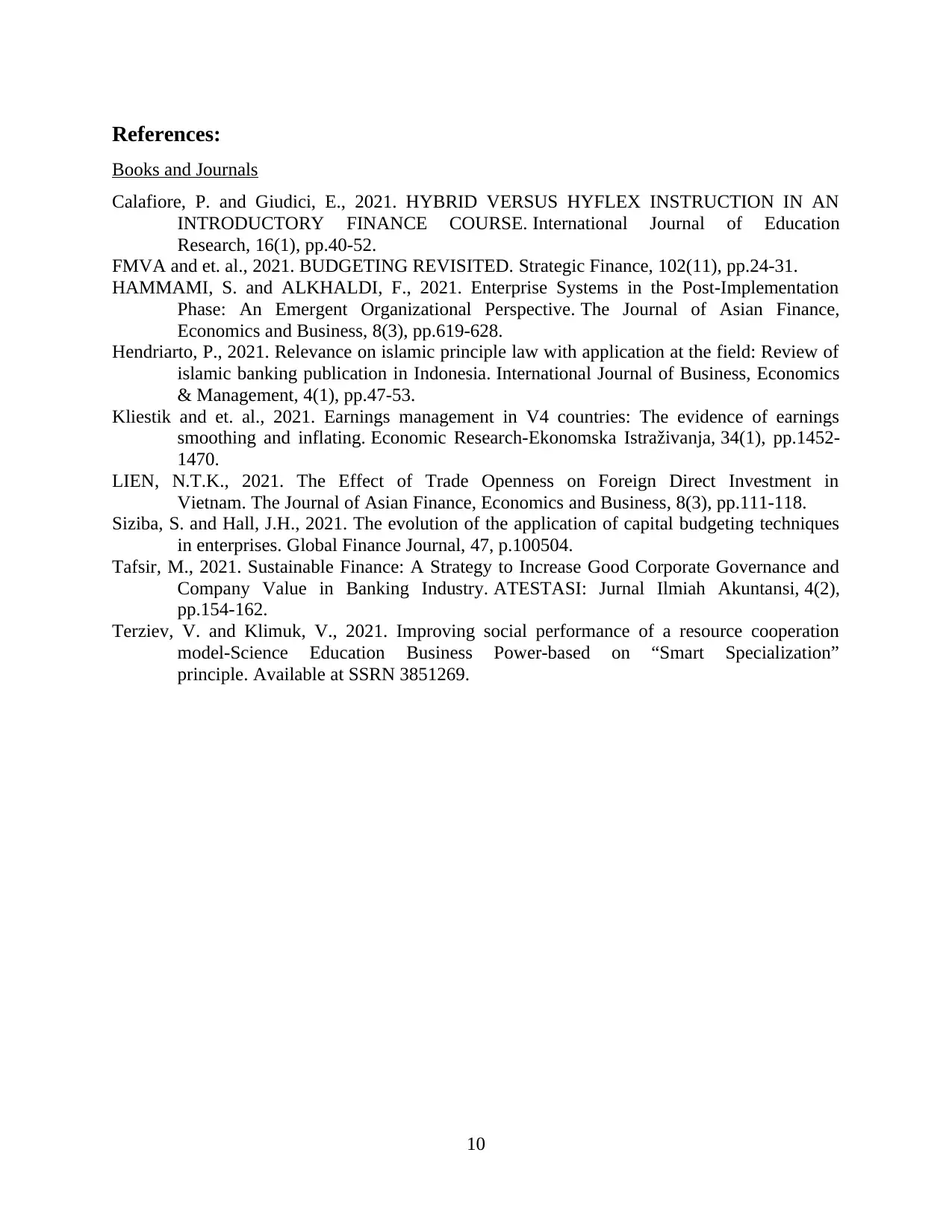
References:
Books and Journals
Calafiore, P. and Giudici, E., 2021. HYBRID VERSUS HYFLEX INSTRUCTION IN AN
INTRODUCTORY FINANCE COURSE. International Journal of Education
Research, 16(1), pp.40-52.
FMVA and et. al., 2021. BUDGETING REVISITED. Strategic Finance, 102(11), pp.24-31.
HAMMAMI, S. and ALKHALDI, F., 2021. Enterprise Systems in the Post-Implementation
Phase: An Emergent Organizational Perspective. The Journal of Asian Finance,
Economics and Business, 8(3), pp.619-628.
Hendriarto, P., 2021. Relevance on islamic principle law with application at the field: Review of
islamic banking publication in Indonesia. International Journal of Business, Economics
& Management, 4(1), pp.47-53.
Kliestik and et. al., 2021. Earnings management in V4 countries: The evidence of earnings
smoothing and inflating. Economic Research-Ekonomska Istraživanja, 34(1), pp.1452-
1470.
LIEN, N.T.K., 2021. The Effect of Trade Openness on Foreign Direct Investment in
Vietnam. The Journal of Asian Finance, Economics and Business, 8(3), pp.111-118.
Siziba, S. and Hall, J.H., 2021. The evolution of the application of capital budgeting techniques
in enterprises. Global Finance Journal, 47, p.100504.
Tafsir, M., 2021. Sustainable Finance: A Strategy to Increase Good Corporate Governance and
Company Value in Banking Industry. ATESTASI: Jurnal Ilmiah Akuntansi, 4(2),
pp.154-162.
Terziev, V. and Klimuk, V., 2021. Improving social performance of a resource cooperation
model-Science Education Business Power-based on “Smart Specialization”
principle. Available at SSRN 3851269.
10
Books and Journals
Calafiore, P. and Giudici, E., 2021. HYBRID VERSUS HYFLEX INSTRUCTION IN AN
INTRODUCTORY FINANCE COURSE. International Journal of Education
Research, 16(1), pp.40-52.
FMVA and et. al., 2021. BUDGETING REVISITED. Strategic Finance, 102(11), pp.24-31.
HAMMAMI, S. and ALKHALDI, F., 2021. Enterprise Systems in the Post-Implementation
Phase: An Emergent Organizational Perspective. The Journal of Asian Finance,
Economics and Business, 8(3), pp.619-628.
Hendriarto, P., 2021. Relevance on islamic principle law with application at the field: Review of
islamic banking publication in Indonesia. International Journal of Business, Economics
& Management, 4(1), pp.47-53.
Kliestik and et. al., 2021. Earnings management in V4 countries: The evidence of earnings
smoothing and inflating. Economic Research-Ekonomska Istraživanja, 34(1), pp.1452-
1470.
LIEN, N.T.K., 2021. The Effect of Trade Openness on Foreign Direct Investment in
Vietnam. The Journal of Asian Finance, Economics and Business, 8(3), pp.111-118.
Siziba, S. and Hall, J.H., 2021. The evolution of the application of capital budgeting techniques
in enterprises. Global Finance Journal, 47, p.100504.
Tafsir, M., 2021. Sustainable Finance: A Strategy to Increase Good Corporate Governance and
Company Value in Banking Industry. ATESTASI: Jurnal Ilmiah Akuntansi, 4(2),
pp.154-162.
Terziev, V. and Klimuk, V., 2021. Improving social performance of a resource cooperation
model-Science Education Business Power-based on “Smart Specialization”
principle. Available at SSRN 3851269.
10
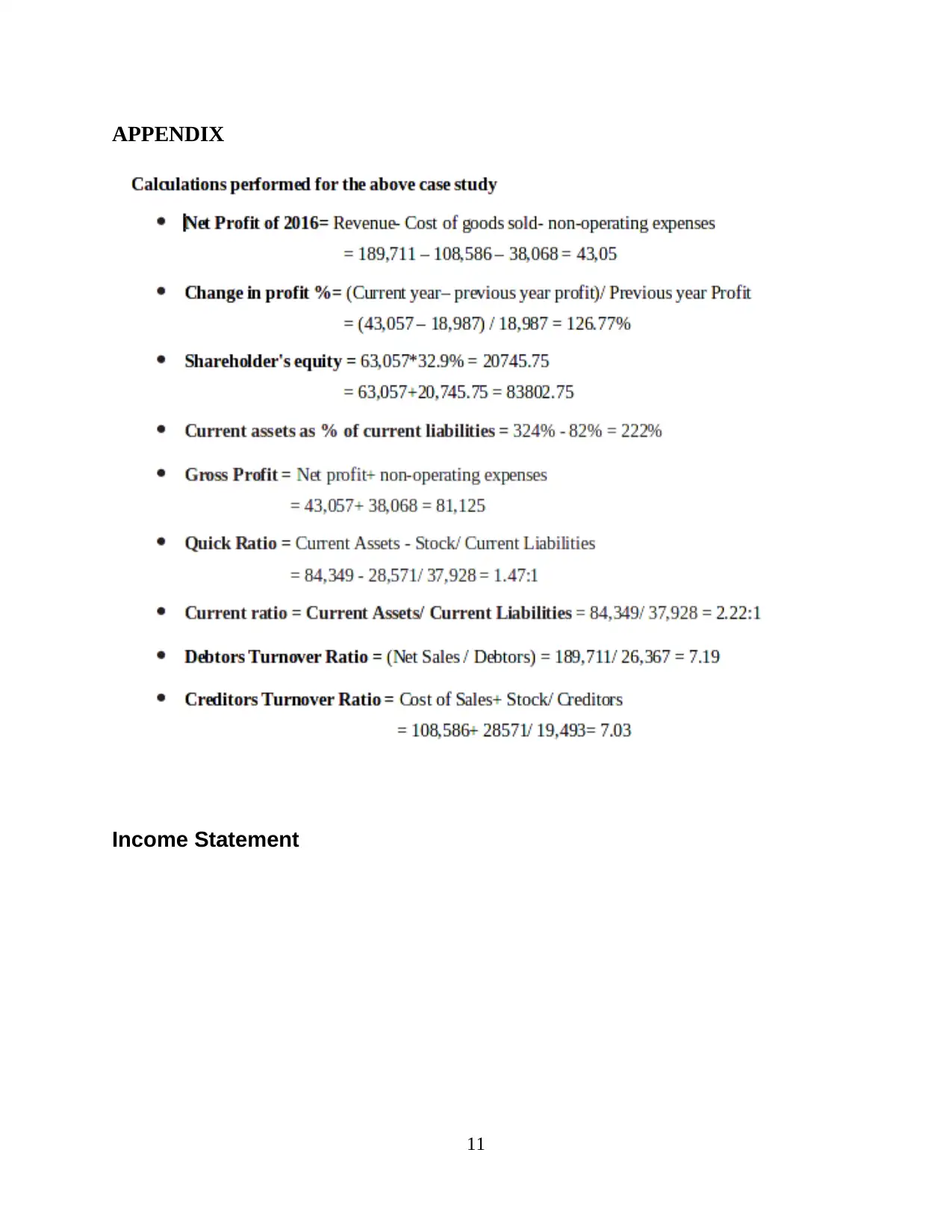
APPENDIX
Income Statement
11
Income Statement
11
Paraphrase This Document
Need a fresh take? Get an instant paraphrase of this document with our AI Paraphraser
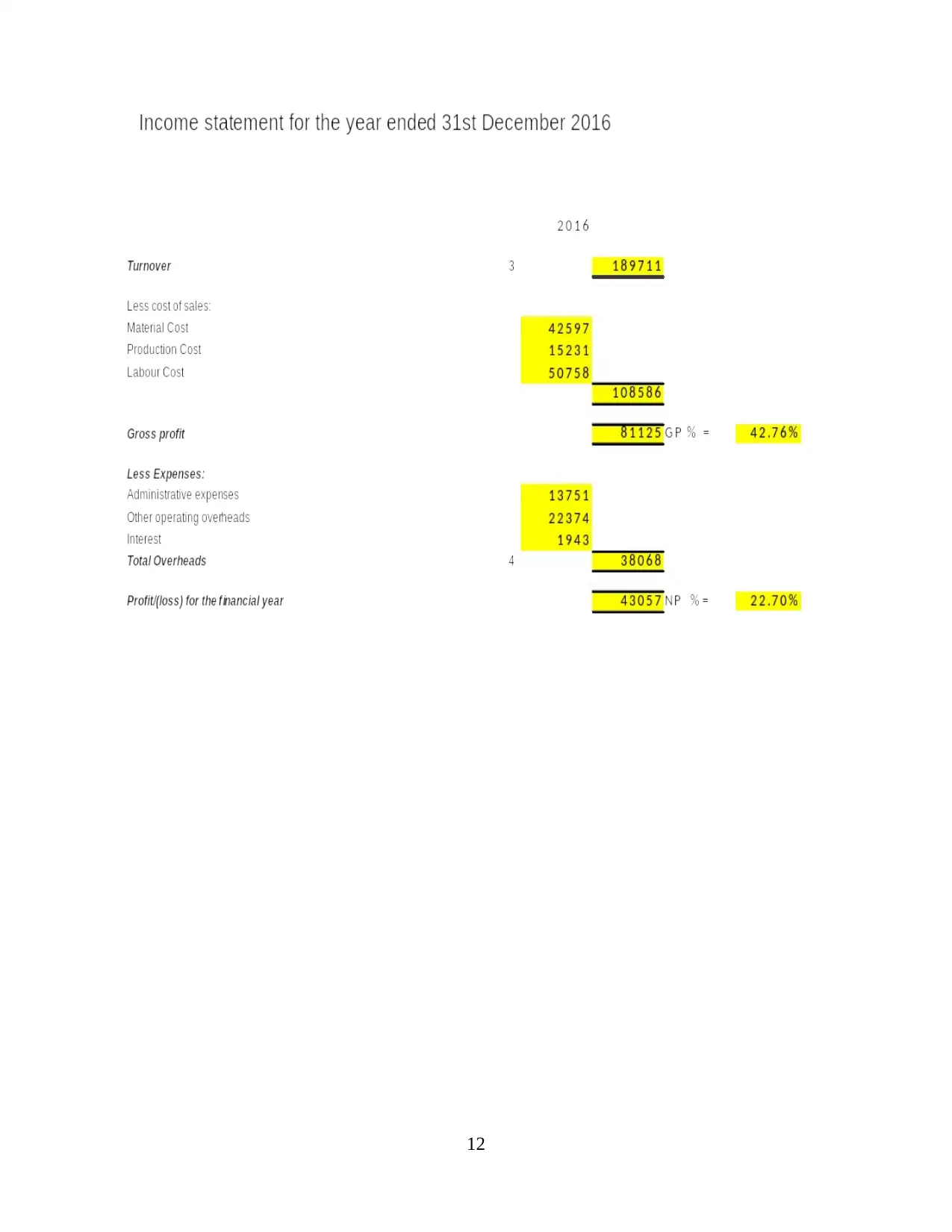
12
1 out of 14
Related Documents
Your All-in-One AI-Powered Toolkit for Academic Success.
+13062052269
info@desklib.com
Available 24*7 on WhatsApp / Email
![[object Object]](/_next/static/media/star-bottom.7253800d.svg)
Unlock your academic potential
© 2024 | Zucol Services PVT LTD | All rights reserved.



